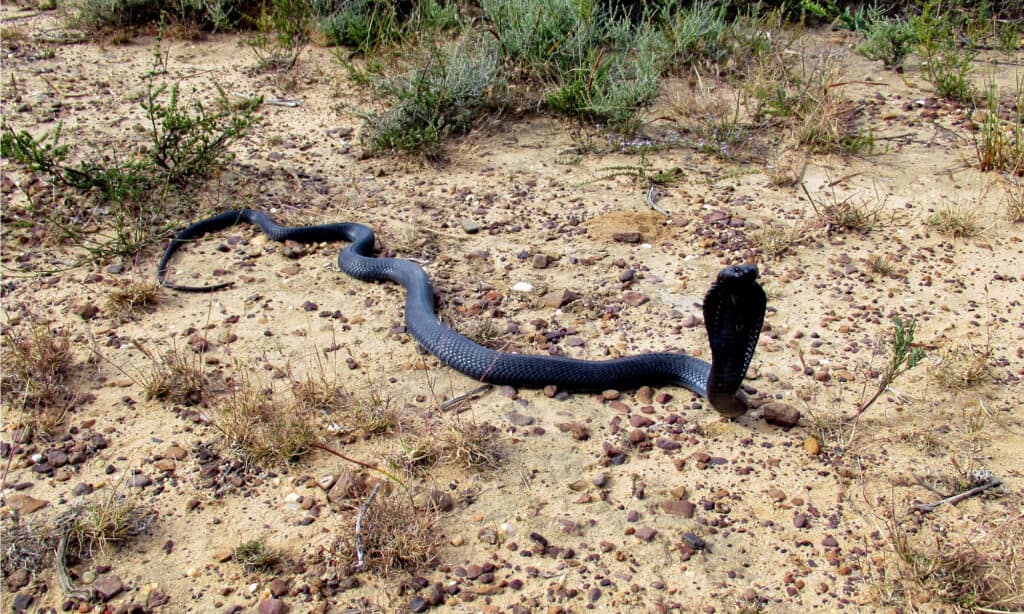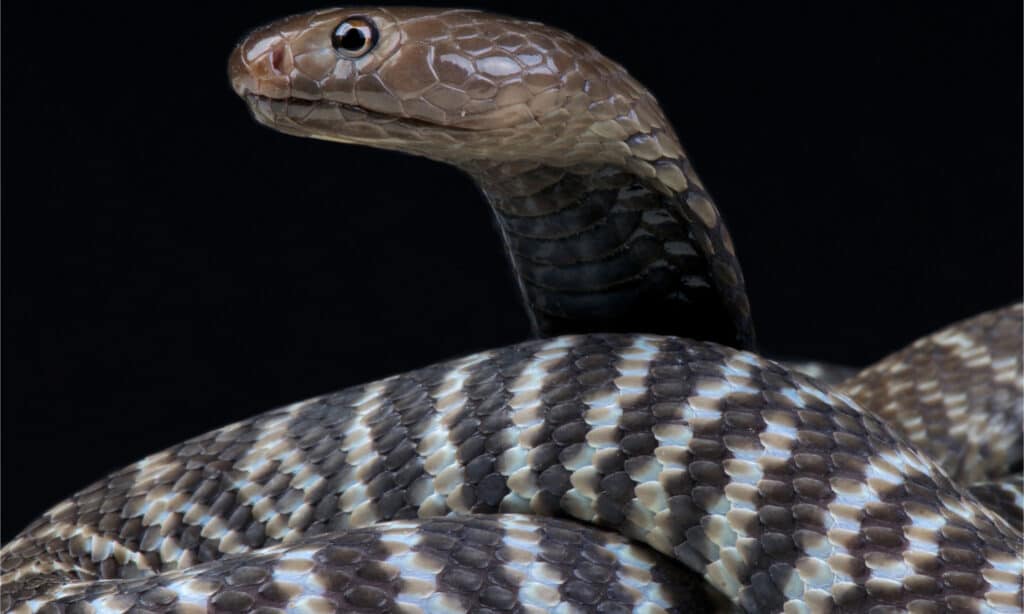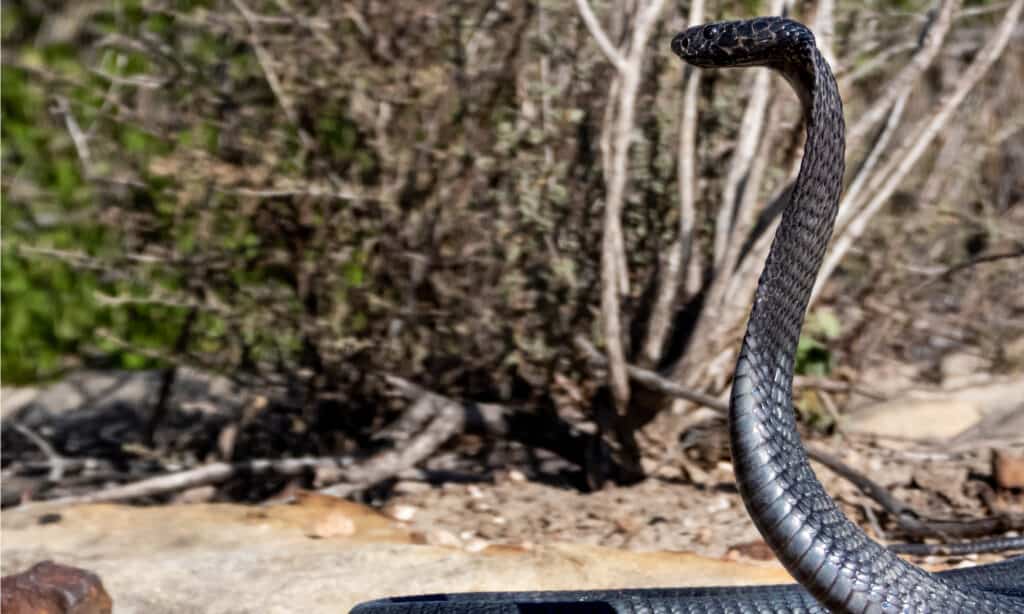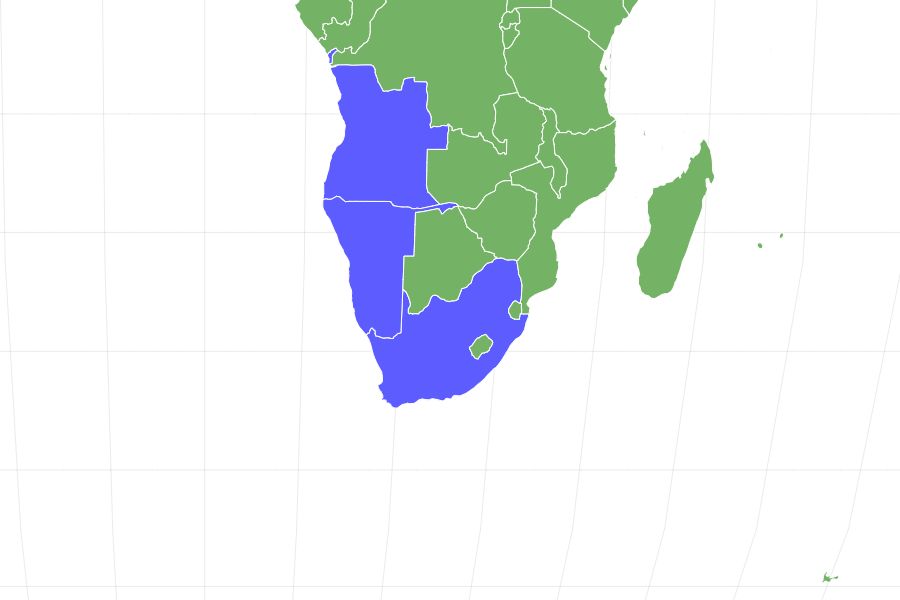Zebra Snake
Naja nigricincta
The zebra snake is a black-hooded species of spitting cobra native to several of the southern countries of Africa.
Advertisement
Zebra Snake Scientific Classification
- Kingdom
- Animalia
- Phylum
- Chordata
- Class
- Reptilia
- Order
- Squamata
- Family
- Elapidae
- Genus
- Naja
- Scientific Name
- Naja nigricincta
Read our Complete Guide to Classification of Animals.
Zebra Snake Conservation Status
Zebra Snake Facts
Zebra Snake Physical Characteristics
- Color
- Black
- Lifespan
- 12+ years
- Length
- 4 feet
- Venomous
- Yes
- Aggression
- Medium
View all of the Zebra Snake images!

The zebra snake is a black-hooded species of spitting cobra native to several of the southern countries of Africa.
The zebra snake is nocturnal, can swim, and its cytotoxic venom is extremely dangerous.
Zebra Snake Amazing Facts

The zebra cobra is capable of ejecting its venom up to a distance of nine feet.
©Willem Van Zyl/Shutterstock.com
- A zebra cobra can spit venom up to nine feet!
- Zebra snakes can live more than 12 years!
- A zebra snake baby hatches at around a foot long!
- Though they are very dangerous, a zebra snake will usually not bite unless it is cornered.
- Though they rarely do so, zebra snakes can bite as well as spit venom.
Evolution and Origins
The zebra spitting cobra is a venomous snake that is indigenous to Africa and can be located in central parts of Namibia, Angola, and Western and Northern Cape provinces of South Africa, living in habitats such as rocky, shrubland, and savanna areas.
The species is indigenous to the arid regions of southern Africa and is mostly active during the night, frequently discovered while crossing roads after dark.
The African zebra snake can be located in the southern regions of Africa such as Namibia, Angola, and South Africa, and it can inhabit various environments such as shrublands, deserts, rocky terrains, and savannas.
Where To Find the Zebra Snake

Zebra Snake or Black Spitting Cobra
©Willem Van Zyl/Shutterstock.com
The African zebra snake can be found all over the southern parts of Africa, including in Namibia, Angola, and South Africa. These spitting cobras may live in shrublands, deserts, rocky areas including mountains and cliffs, and also in the savanna. Western barred spitting cobras can be found on or under rocks, hanging in or climbing trees, swimming in bodies of water, or hiding in tall grasses.
Scientific Name

N. Nigricincta is the scientific name for the western barred spitting cobra, also known as the zebra snake.
©reptiles4all/Shutterstock.com
The scientific name for the zebra snake, or western barred spitting cobra, is N. Nigricincta. “Naja” means cobra and “nigricincta” means black in Latin. There is some debate as to whether they are a subspecies of the Black-necked Spitting Cobra, Naja nigricollis whose name means “blackfish cobra.”
Population and Conservation Status

Zebra Snake or Black Spitting Cobra
©Willem Van Zyl/Shutterstock.com
According to the ICUN Redlist, the African zebra snake is listed as being of Least Concern. Their population is listed as stable and they have few if any natural threats and none determined by the ICUN. They were last assessed for the Red List in 2019.
Appearance and Description
A fully grown zebra snake is approximately four feet in length, but a baby zebra snake is born a foot long, so their size may not help identify them. The zebra snake is most easily identified by its black cobra hood and the stripes from which it gets its name, black and white “zebra” stripes which band the length of the zebra cobra’s body.
The head and hood of the zebra snake are both solid black, with no white stripes or bands.
Venom: How Dangerous Are They?
Given their potential nine-foot venom-spitting range and their preference for spitting from hidden locations, a zebra snake should be considered quite dangerous. The cytotoxin they spit can cause a range of injuries. “Cytotoxin” means a poison that destroys cell tissue. This means it is extremely dangerous to have a zebra snake spit on one’s skin or especially in one’s eyes.
Some of the effects of the toxin are pain, swelling, necrotic tissue, blindness, paralysis, and in rare cases even death. The African Snake Bite Institute rates their venom as “very dangerous.” In case of contact with their venom, affected eyes and skin should immediately be flushed well with running water and medical attention should be sought.
Behavior and Humans
The African zebra snake is not highly aggressive unless they are cornered or about to lay eggs. However, they will defend themselves when a human comes upon them unawares and this can happen easily since they like to hide on the ground, in trees, and even swim in river water.
The effects of their venom can be quite severe, so precautions should be taken whenever venturing into their territory.
View all 14 animals that start with ZZebra Snake FAQs (Frequently Asked Questions)
Is the zebra snake venomous?
Yes, a zebra snake is venomous and spits a very dangerous cytotoxin, which is a poison that destroys cell tissue with contact.
Are zebra snakes aggressive?
While they do not attack unless cornered or provoked, yes, zebra snakes are aggressive when defending themselves, their eggs or their territory.
Is zebra snake a cobra?
Yes, a zebra snake is another name for the western barred spitting cobra, also known as the zebra cobra.
How long do zebra snakes live?
A zebra snake can have a lifespan over 12 years.
What is the habitat of a zebra snake?
The zebra snake lives in deserts, shrublands, savannas and rocky regions such as cliffs and mountains.
How far can a zebra snake spit?
A zebra snake is capable of spitting venom up to three yards away.
Thank you for reading! Have some feedback for us? Contact the AZ Animals editorial team.
Sources
- https://www.hetterrarium.com/en_GB/a-53882450/venomous-reptiles/naja-nigricincta-info-care/ (1970) Western Barred Spitting Cobra Info and Care
- https://eol.org/pages/47045878 (1970) Encyclopedia of Life: Western Barred Spitting Cobra
- https://animalia.bio/black-necked-spitting-cobra (1970) Western Barred Spitting Cobra Mating Habits
- https://www.newsweek.com/venomous-spitting-zebra-cobra-that-terrorized-community-was-secretly-loose-months-1608014 (1970) Poisonous African Western Barred Spitting Cobra
- https://www.the-sun.com/news/3186326/how-dangerous-are-zebra-cobras/ (1970) How Dangerous Are Zebra Cobras?
- https://www.facebook.com/groups/187156948143224/posts/1312118542313720/ (1970) African Zebra Snakes Poisonous Bite Effects
- https://en.wikipedia.org/wiki/Naja_nigricincta (1970) Zebra Snake Wiki
- https://www.hetterrarium.com/en_GB/a-53882450/venomous-reptiles/naja-nigricincta-info-care/ (1970) Zebra Snake Lifespan
- https://www.washingtonpost.com/nation/2021/07/02/raleigh-escaped-zebra-cobra-captured/ (1970) Raleigh Escaped Western Barred Spitting Zebra Cobra Spit Distance
- https://en.wikipedia.org/wiki/Black-necked_spitting_cobra (1970) What Do Western Barred Spitting Cobras Eat?
- https://www.wildrepublic.com/product/cobra/ (1970) Do Western Barred Spitting Cobras Swim in Water?
- https://www.science.org/content/article/spitting-cobras-venom-evolved-inflict-pain (1970) Do Western Barred Spitting Cobras Bite?
- https://www.africansnakebiteinstitute.com/snake/zebra-cobra/ (1970) African Snake Bite Institute: Zebra Cobra Western Barred Spitting Cobra
- http://www.the-eis.com/atlas/?q=snake-description&taxon_meaning_id=2973 (1970) Poisonous Western Barred Spitting Cobra (Zebra Cobra) Identification


















